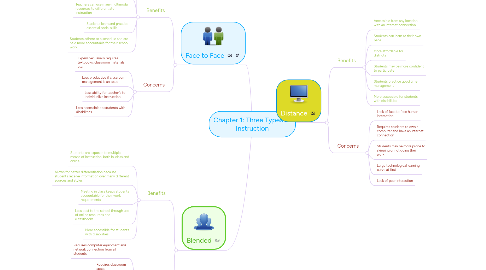
1. Face to Face
1.1. Benefits
1.1.1. Face to face human interaction
1.1.2. Peer interaction and relationships
1.1.3. Teachers can use many multimodal resources to differentiate instruction
1.1.4. Students learn and practice essential social skills
1.1.5. Students adhere to a schedule and are held more accountable for their school work
1.2. Concerns
1.2.1. Expensive: usually requires textbooks, classroom materials, etc.
1.2.2. Less productive if classroom management is an issue
1.2.3. Less ability for teacher's to individualize instruction
1.2.4. Less accessible to students with disabilities
2. Blended
2.1. Benefits
2.1.1. Students are exposed to multiple means of instruction, both in-class and online
2.1.2. Allows for better differentiation because students receive information over many different sources and styles
2.1.3. Meeting in class keeps students accountable for their work requirements
2.1.4. Less cost to the school through use of online resources and e-textbooks
2.1.5. More accessible for students with disabilities
2.2. Concerns
2.2.1. Requires computer equipment and network connection from all students.
2.2.2. Requires classroom space
2.2.3. Learning curve to adapt to online portion
2.2.4. Students need to have extremely good time management to succeed
3. Distance
3.1. Benefits
3.1.1. Accessible from any location with an internet connection
3.1.2. Students can learn at their own pace
3.1.3. More affordable for districts
3.1.4. Students may be more confident to participate
3.1.5. Students practice good time management
3.1.6. More accessible for students with disabilities
3.2. Concerns
3.2.1. Lack of face to face human interaction
3.2.2. Requires students to own a computer and have an internet connection
3.2.3. Students may be more prone to skipping or not doing their work
3.2.4. Large technological learning curve at first
3.2.5. Lack of peer interaction
